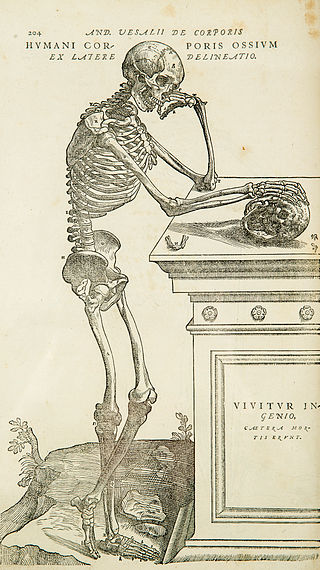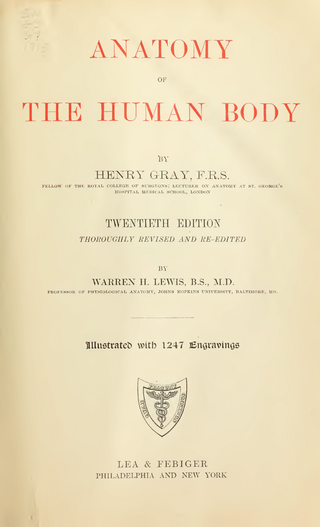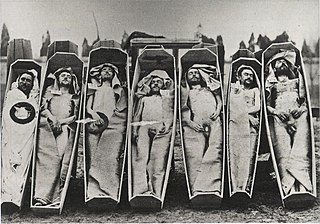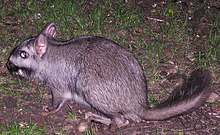
Anatomy is the branch of biology concerned with the study of the structure of organisms and their parts. Anatomy is a branch of natural science that deals with the structural organization of living things. It is an old science, having its beginnings in prehistoric times. Anatomy is inherently tied to developmental biology, embryology, comparative anatomy, evolutionary biology, and phylogeny, as these are the processes by which anatomy is generated, both over immediate and long-term timescales. Anatomy and physiology, which study the structure and function of organisms and their parts respectively, make a natural pair of related disciplines, and are often studied together. Human anatomy is one of the essential basic sciences that are applied in medicine.

The human body is the structure of a human being. It is composed of many different types of cells that together create tissues and subsequently organ systems. They ensure homeostasis and the viability of the human body.

Gray's Anatomy is a reference book of human anatomy written by Henry Gray, illustrated by Henry Vandyke Carter, and first published in London in 1858. It has gone through multiple revised editions and the current edition, the 42nd, remains a standard reference, often considered "the doctors' bible".

A joint or articulation is the connection made between bones, ossicles, or other hard structures in the body which link an animal's skeletal system into a functional whole. They are constructed to allow for different degrees and types of movement. Some joints, such as the knee, elbow, and shoulder, are self-lubricating, almost frictionless, and are able to withstand compression and maintain heavy loads while still executing smooth and precise movements. Other joints such as sutures between the bones of the skull permit very little movement in order to protect the brain and the sense organs. The connection between a tooth and the jawbone is also called a joint, and is described as a fibrous joint known as a gomphosis. Joints are classified both structurally and functionally.

The maxilla in vertebrates is the upper fixed bone of the jaw formed from the fusion of two maxillary bones. In humans, the upper jaw includes the hard palate in the front of the mouth. The two maxillary bones are fused at the intermaxillary suture, forming the anterior nasal spine. This is similar to the mandible, which is also a fusion of two mandibular bones at the mandibular symphysis. The mandible is the movable part of the jaw.

Comparative anatomy is the study of similarities and differences in the anatomy of different species. It is closely related to evolutionary biology and phylogeny.

The nasal bones are two small oblong bones, varying in size and form in different individuals; they are placed side by side at the middle and upper part of the face and by their junction, form the bridge of the upper one third of the nose.

A fascia is a band or sheet of connective tissue, primarily collagen, beneath the skin that attaches to, stabilizes, encloses, and separates muscles and other internal organs. Fascia is classified by layer, as superficial fascia, deep fascia, and visceral or parietal fascia, or by its function and anatomical location.

Morphology is a branch of biology dealing with the study of the form and structure of organisms and their specific structural features.
Grey's Anatomy is an American medical drama television series that premiered on March 27, 2005, on ABC as a mid-season replacement. The series focuses on the lives of surgical interns, residents, and attendings as they develop into seasoned doctors while balancing personal and professional relationships. The title is an allusion to Gray's Anatomy, a classic human anatomy textbook first published in 1858 in London and written by Henry Gray. Shonda Rhimes developed the pilot and continued to write for the series until 2015. Krista Vernoff, who previously worked with Rhimes, is now the showrunner. Rhimes was also one of the executive producers alongside Betsy Beers, Mark Gordon, Krista Vernoff, Rob Corn, Mark Wilding, Allan Heinberg, and Ellen Pompeo. Although the series is set in Seattle, Washington, it is filmed primarily in Los Angeles, California, and Vancouver, British Columbia.

Ellen Kathleen Pompeo is an American actress. She is best known for her role on Grey's Anatomy as the titular Dr. Meredith Grey. One of the world's highest-paid actors since 2017, she has made multiple appearances on the Forbes’ year-end lists. Her accolades include a Screen Actors Guild Award and a Golden Globe Award nomination.

Shonda Lynn Rhimes is an American television screenwriter, producer, and author. She is best known as the showrunner—creator, head writer, and executive producer—of the television medical drama Grey's Anatomy, its spin-off Private Practice, and the political thriller series Scandal. Rhimes has also served as the executive producer of the ABC television series Off the Map, How to Get Away with Murder, The Catch, and Grey's spin-off Station 19.

In vertebrate anatomy, hip refers to either an anatomical region or a joint.

Plant anatomy or phytotomy is the general term for the study of the internal structure of plants. Originally it included plant morphology, the description of the physical form and external structure of plants, but since the mid-20th century plant anatomy has been considered a separate field referring only to internal plant structure. Plant anatomy is now frequently investigated at the cellular level, and often involves the sectioning of tissues and microscopy.
The Foundational Model of Anatomy Ontology (FMA) is a reference ontology for the domain of Human anatomy. It is a symbolic representation of the canonical, phenotypic structure of an organism; a spatial-structural ontology of anatomical entities and relations which form the physical organization of an organism at all salient levels of granularity.

A cadaver or corpse is a dead human body. Cadavers are used by medical students, physicians and other scientists to study anatomy, identify disease sites, determine causes of death, and provide tissue to repair a defect in a living human being. Students in medical school study and dissect cadavers as a part of their education. Others who study cadavers include archaeologists and arts students.

Katherine Marie Heigl is an American actress and former fashion model. She played Dr. Izzie Stevens on the ABC television medical drama Grey's Anatomy from 2005 to 2010, a role that brought her recognition and accolades, including the Primetime Emmy Award for Outstanding Supporting Actress in a Drama Series in 2007.

The spinal column, a defining synapomorphy shared by nearly all vertebrates, is a moderately flexible series of vertebrae, each constituting a characteristic irregular bone whose complex structure is composed primarily of bone, and secondarily of hyaline cartilage. They show variation in the proportion contributed by these two tissue types; such variations correlate on one hand with the cerebral/caudal rank, and on the other with phylogenetic differences among the vertebrate taxa.

Anatomy of a Scandal is an American thriller drama streaming television miniseries developed by David E. Kelley and Melissa James Gibson, based on the novel of the same name by Sarah Vaughan. The series consists of six episodes, and premiered on Netflix on April 15, 2022.

















